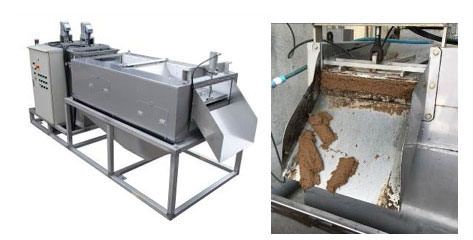KDS Sludge Dewatering Technology for Small-to-medium Councils
Published on by Water Network Research, Official research team of The Water Network in Technology
A compact and cost-efficient alternative to conventional sludge dewatering technologies is being introduced to Australia to eliminate costs and OH&S hazards associated with damper and heavier output from municipal wastewater treatment plants.

CST Wastewater Solutions’ KDS separator
(See an animation of the rollers here. See a video of sludge digestion here.)
Source: CST Wastewater
The KDS Multidisc Roller system from CST Wastewater Solutions – which requires no washwater, while capturing 90-99 per cent of solids – is engineered to overcome the limitations of technologies such as screw presses, belt presses and centrifuges typically employed in small-to-medium applications.
Used for thickening of dissolved air flotation sludge – a very common application throughout waste water operations – it achieves solids capture of 97 per cent thickened sludge at a dryness of 17 per cent. Waste activated sludge dryness levels are typically 15-18 per cent dryness.
The high quality, Japanese-manufactured technology:
- Uses minimal energy, consuming as little as 0.06kW hr of electricity
- Operates at low (63dBa) non-intrusive noise and vibration levels
- Requires minimal daily maintenance, saving cost and enhancing OH&S performance
- Occupies typically half the space or less of conventional dewatering plants
This lighter, dryer waste it produces reduces the need for manual labour in cleaning and transport operations and curtails the need for council staff to handle sloppy heavy waste potentially hazardous to health.
The largest KDS unit can handle about 100kg DS (dry solids) an hour at 98 per cent solids capture, to produce this more hygienic and more compact output that is easier and more hygienic to handle and transport, says CST Wastewater Solutions Managing Director Mr Michael Bambrige.
“With the KDS’ minimal water, power and space demands, it is ideally suited to both smaller-to-medium councils and to those operating in remote or environmentally sensitive situations,” said Mr Bambridge.
How it works

The technology involved in KDS separators, which have been proven in thousands of applications worldwide and recently specified in Australasia for use as a major element of a CST Wastewater Solutions installation on the World Heritage listed Lord Howe Island (see full story here)
The clog-free automatic liquid-to-solid waste separator dewaters conditioned sludge on a self-cleaning wedgewire belt. This static belt is cleaned by a unique set of rotating oval shape plates.
After the drainage and thickening zone, the thickened sludge passes a dewatering zone which consists of an adjustable plate, actuated manually or by pneumatic cylinder.
The KDS’ unique self-cleaning dewatering and conveying system features an oval plate separation and transfer structure that prevents clogging and permits automatic continuous operation that handles oily and fibrous material with ease.
“This simple-to-maintain separator offers a high throughput within a small body, with the smallest model being just under 350mm wide and weighing 50 kg. The compact rotational oval plate structure achieves high transportation and separation efficiencies, while the simplicity of the machine’s overall structure offers low maintenance, achieving cost and OH&S benefits through less handling being required to clear hazardous materials.
“The KDS separator uses a fraction of the power of a centrifuge and requires no water usage during operation, unlike a belt press or a screw press. For a relatively low investment cost, it also offers a high performance alternative to sludge drying beds and geobags, for example,” says Mr Bambridge.
The unique self-cleaning action of the KDS separator, which is available in hydraulic capacities from 264-4092 gal/hr (999-15489 litres) with input solids content of 2 per cent
Applications for which the separator is designed include:
- Food processing waste, including snackfoods, kitchen and restaurant waste, raw wastewater (primary screening) and sludge
- Sewage treatment, including raw wastewater (primary screening) and sludge to landfill
- Abattoir, feedlots, and dairy farm wastewater and sludge. Cattle manure cake dryness of 25-35 per cent is typically achieved
- Pig farm raw manure and sludge, with cake dryness of 20-30 per cent
- Barrel polishing water, water-based paint wastewater, grease trap waste, dyeing wastewater, waste oil, and plastic recycling
- Seafood processing
Source: CST Wastewater
Media
Taxonomy
- Reclaimed Wastewater
- Sludge Treatment
- Sludge Management
- Technology
- Wastewater Treatment
- Wastewater Collection
- Dewatering